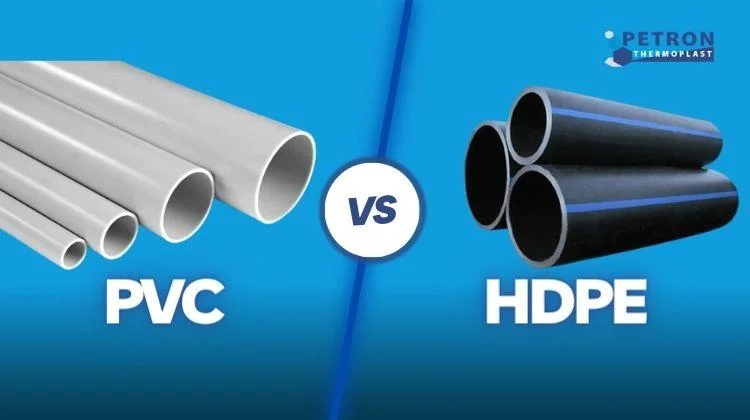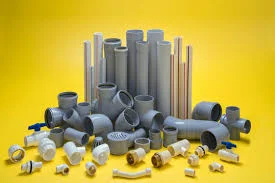If you’re setting up a water supply system—whether for a home, farm, or entire community—you’ll likely face a common question: Should you choose HDPE or uPVC pipes? Both are widely used in Pakistan, but their properties, performance, and costs differ in important ways. Let’s compare them in detail so you can make an informed choice.
What are HDPE and uPVC pipes?
HDPE (High-Density Polyethylene) pipes are made from a strong, flexible thermoplastic. They are known for their smooth inner surface, resistance to corrosion, and ability to handle ground movement without cracking. They are joined through butt fusion or electrofusion, creating leak-proof joints. uPVC (Unplasticised Polyvinyl Chloride) pipes are rigid, strong, and corrosion-resistant. They are joined using solvent cement or rubber-ring fittings. uPVC is lightweight, cost-effective, and commonly used for cold water supply and drainage systems.
HDPE or uPVC pipes
Home
Committed To Excellence +92 333 5665265 We Manufacture High Quality Pipes & Fittings The establishment of the company in the year 2000 was prompted by a growing need for high-quality galvanized pipes, polyethene pipes, HDPE
How does durability compare between HDPE and uPVC?
- HDPE: Extremely resistant to cracking, impact, and stress from soil movement. Ideal for underground installations in unstable or varied terrain. Lifespan can exceed 50 years with proper installation.
- uPVC: Strong but rigid—less able to handle ground shifts. Works best in stable soil conditions. Lifespan can be 25–40 years when protected from direct sunlight and extreme impact.
Which is better for handling water pressure?
- HDPE: Available in multiple pressure ratings (PN6 to PN20). Flexible enough to absorb pressure surges (water hammer), making it suitable for pumped systems and high-pressure networks.
- uPVC: Good for moderate pressure systems. Available in pressure classes (e.g., Class B, Class C). Less forgiving to sudden pressure spikes compared to HDPE.
How do they compare in terms of leak prevention?
- HDPE: Fusion jointing (butt or electrofusion) creates joints as strong as the pipe itself, virtually eliminating leaks.
- uPVC: Relies on mechanical joints or solvent welding, which can leak if not installed correctly or if rubber rings age over time.
Which one is more flexible and easier to install in challenging terrain?
- HDPE: Can bend to follow curves, reducing the need for fittings. Perfect for routes with elevation changes, uneven land, or crossing roads without extensive excavation.
- uPVC: Rigid and requires fittings for every change in direction. Better suited for straight runs and above-ground installations.
What about chemical and corrosion resistance?
Both materials resist rust and corrosion.- HDPE: Excellent chemical resistance; suitable for acidic, alkaline, and saline water.
- uPVC: Also corrosion-resistant, but less resistant to certain organic solvents compared to HDPE.
How do installation costs differ?
- HDPE: The pipe itself can be more expensive than uPVC, and fusion equipment is needed for jointing. However, fewer fittings and faster trenching in challenging terrain can offset these costs in the long run.
- uPVC: Lower initial pipe and fitting costs. Easy to cut and join without special equipment, making it cheaper for small, simple systems.
Which one performs better in rural Pakistan?
- HDPE: Ideal for rural systems where pipelines run long distances underground through varied landscapes. Low leak risk, high durability, and flexibility make it a strong choice.
- uPVC: Suitable for stable, straight routes or where budget is very tight. Works well for short connections and low-maintenance areas.
What are the temperature limitations?
- HDPE: Performs well in both cold and hot climates. Can handle sub-zero temperatures without becoming brittle. Maximum continuous service temperature is around 60°C.
- uPVC: Best for cold water applications. Becomes brittle in extreme cold and can warp if exposed to hot water for long periods.
How do maintenance requirements compare?
- HDPE: Minimal maintenance when installed properly. Fusion joints reduce leak risks. Repairs, if needed, require fusion equipment.
- uPVC: Easy to replace or repair sections with basic tools, but joints may require more frequent checks for leaks over the years.
What about availability in Pakistan?
Both HDPE and uPVC are widely available through local manufacturers, dealers, and hardware stores. HDPE is often stocked in larger diameters for municipal and agricultural use, while uPVC is common for residential plumbing and small-scale projects.Cost comparison summary
| Factor | HDPE Pipe | uPVC Pipe |
| Initial Cost | Higher per meter | Lower per meter |
| Fittings | Fewer needed due to flexibility | More fittings needed |
| Jointing | Butt/electrofusion (special equipment) | Solvent cement or rubber ring (simple) |
| Maintenance | Low (if installed well) | Moderate (occasional leak repairs) |
| Lifespan | 50+ years | 25–40 years |
Which one should you choose?
- Choose HDPE if: You have a long-distance rural pipeline, need leak-proof performance, want a 50+ year lifespan, and can invest a bit more upfront.
- Choose uPVC if: You have a smaller budget, need a rigid pipe for above-ground or straight underground runs, and want an easy-to-install system without specialised tools.
FAQs
1) Is HDPE always better than uPVC for water supply? Not always. HDPE is better for flexibility, high pressure, and long-term reliability, while uPVC is cheaper and suitable for straightforward, low-pressure systems. 2) Can uPVC handle drinking water safely? Yes, if certified for potable water use. Always check PSQCA and ISO compliance. 3) Which pipe is more eco-friendly? Both are recyclable, but HDPE’s longer lifespan can make it more sustainable over time. 4) Does HDPE need more skilled labor for installation? Yes, fusion welding requires trained technicians, but this ensures leak-proof joints. 5) Can I mix HDPE and uPVC in the same system? Yes, with proper adapters, but it’s better to keep materials consistent to simplify maintenance.Wrap-up
When it comes to HDPE water pipe vs uPVC in Pakistan, there’s no one-size-fits-all answer. HDPE offers unmatched durability, flexibility, and leak prevention, making it ideal for large-scale, rural, or high-pressure projects. uPVC, on the other hand, remains a budget-friendly, easy-to-install option for small-scale and low-pressure applications.Your choice should depend on your budget, terrain, water pressure, and how long you want the system to last without major maintenance.



